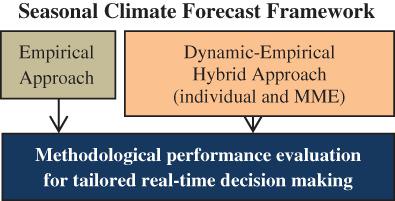当前位置:
X-MOL 学术
›
Int. J. Climatol.
›
论文详情
Our official English website, www.x-mol.net, welcomes your feedback! (Note: you will need to create a separate account there.)
Improved multi-model ensemble forecasts of Iran's precipitation and temperature using a hybrid dynamical-statistical approach during fall and winter seasons
International Journal of Climatology ( IF 3.9 ) Pub Date : 2021-04-21 , DOI: 10.1002/joc.7148 Husain Najafi 1, 2 , Andrew W. Robertson 3 , Ali R. Massah Bavani 2 , Parviz Irannejad 4 , Niko Wanders 5 , Eric F. Wood 6
International Journal of Climatology ( IF 3.9 ) Pub Date : 2021-04-21 , DOI: 10.1002/joc.7148 Husain Najafi 1, 2 , Andrew W. Robertson 3 , Ali R. Massah Bavani 2 , Parviz Irannejad 4 , Niko Wanders 5 , Eric F. Wood 6
Affiliation

|
Skillful seasonal climate forecasts can support decision making in water resources management and agricultural planning. In arid and semi-arid regions, tailoring reliable forecasts has the potential to improve water management by using key hydroclimate variables months in advance. This article analyses and compares the performance of two common approaches (empirical and hybrid dynamical-statistical) in seasonal climate forecasting over a drought-prone area located in Southwest Asia including Iran. Empirical models are framed as a baseline skill that hybrid models need to outperform. Both approaches provide probabilistic forecasts of precipitation and temperature using canonical correlation analysis to provide forecasts at 0.25° resolution. Empirical models are developed based on the large-scale observed atmosphere–ocean patterns for forecasting using antecedent climate anomalies as predictors, while the hybrid approach makes use of model output statistics to correct systematic errors in dynamical climate model forecast outputs. Eight state-of-the-art dynamical models from the North American Multi-Model Ensemble project are analysed. Individual models with the highest goodness index are weighted to develop seven different hybrid dynamical-statistical Multi-model Ensembles. In this study, (October–December) and (January–February) are considered as target seasons which are the most important periods within the water year for water resource allocation to the agriculture sector. The results show that the hybrid approach has improved performance compared to the raw general circulation models and purely empirical models, and that the performance of the hybrid models is season-dependent. Seasonal forecasts of precipitation (temperature) have a higher skill in OND (JFM). In addition, in most cases, Multi-model Ensemble (MME) is more skillful than the empirical models and outperforms individual dynamical models. However, the best individual model might be as skillful as the MME given the target season and region of interest.
中文翻译:

在秋季和冬季使用混合动力统计方法改进伊朗降水和温度的多模式集合预报
熟练的季节性气候预测可以支持水资源管理和农业规划的决策。在干旱和半干旱地区,通过提前几个月使用关键的水文气候变量,定制可靠的预报有可能改善水资源管理。本文分析和比较了两种常用方法(经验和混合动力统计)在包括伊朗在内的西南亚干旱多发地区的季节性气候预测中的性能。经验模型被定义为混合模型需要超越的基本技能。这两种方法都使用典型相关分析来提供降水和温度的概率预报,以提供 0.25° 分辨率的预报。经验模型是基于大尺度观测的大气-海洋模式开发的,用于使用先行气候异常作为预测因子进行预测,而混合方法利用模型输出统计来纠正动态气候模型预测输出中的系统误差。分析了来自北美多模型集成项目的八个最先进的动力学模型。具有最高优良指数的单个模型被加权以开发七个不同的混合动力统计多模型集成。在本研究中,(10 月至 12 月)和(1 月至 2 月)被视为目标季节,这些季节是水年度中农业部门水资源分配的最重要时期。结果表明,与原始大环流模型和纯经验模型相比,混合方法提高了性能,并且混合模型的性能与季节有关。降水(温度)的季节性预测在OND(JFM)方面具有更高的技能。此外,在大多数情况下,多模型集成(MME)比经验模型更熟练,并且优于单个动力学模型。然而,考虑到目标季节和感兴趣的区域,最好的个人模型可能与 MME 一样熟练。多模型集成(MME)比经验模型更熟练,并且优于单个动力学模型。然而,考虑到目标季节和感兴趣的区域,最好的个人模型可能与 MME 一样熟练。多模型集成(MME)比经验模型更熟练,并且优于单个动力学模型。然而,考虑到目标季节和感兴趣的区域,最好的个人模型可能与 MME 一样熟练。
更新日期:2021-04-21
中文翻译:

在秋季和冬季使用混合动力统计方法改进伊朗降水和温度的多模式集合预报
熟练的季节性气候预测可以支持水资源管理和农业规划的决策。在干旱和半干旱地区,通过提前几个月使用关键的水文气候变量,定制可靠的预报有可能改善水资源管理。本文分析和比较了两种常用方法(经验和混合动力统计)在包括伊朗在内的西南亚干旱多发地区的季节性气候预测中的性能。经验模型被定义为混合模型需要超越的基本技能。这两种方法都使用典型相关分析来提供降水和温度的概率预报,以提供 0.25° 分辨率的预报。经验模型是基于大尺度观测的大气-海洋模式开发的,用于使用先行气候异常作为预测因子进行预测,而混合方法利用模型输出统计来纠正动态气候模型预测输出中的系统误差。分析了来自北美多模型集成项目的八个最先进的动力学模型。具有最高优良指数的单个模型被加权以开发七个不同的混合动力统计多模型集成。在本研究中,(10 月至 12 月)和(1 月至 2 月)被视为目标季节,这些季节是水年度中农业部门水资源分配的最重要时期。结果表明,与原始大环流模型和纯经验模型相比,混合方法提高了性能,并且混合模型的性能与季节有关。降水(温度)的季节性预测在OND(JFM)方面具有更高的技能。此外,在大多数情况下,多模型集成(MME)比经验模型更熟练,并且优于单个动力学模型。然而,考虑到目标季节和感兴趣的区域,最好的个人模型可能与 MME 一样熟练。多模型集成(MME)比经验模型更熟练,并且优于单个动力学模型。然而,考虑到目标季节和感兴趣的区域,最好的个人模型可能与 MME 一样熟练。多模型集成(MME)比经验模型更熟练,并且优于单个动力学模型。然而,考虑到目标季节和感兴趣的区域,最好的个人模型可能与 MME 一样熟练。


























 京公网安备 11010802027423号
京公网安备 11010802027423号